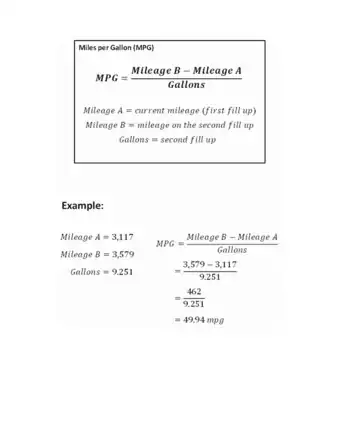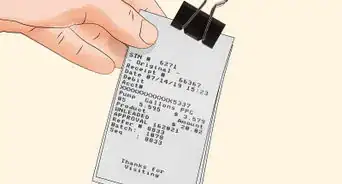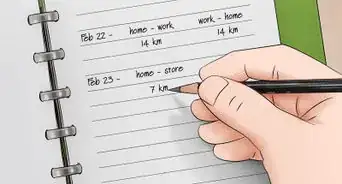wikiHow is a “wiki,” similar to Wikipedia, which means that many of our articles are co-written by multiple authors. To create this article, 59 people, some anonymous, worked to edit and improve it over time.
This article has been viewed 904,425 times.
Learn more...
As gas prices rise, fuel efficiency is becoming more and more of a critical factor. Knowing your car's MPG (that is, how many miles it gets per gallon) can help you determine if it's a gas guzzler that's eating up your cash. Once you figure out the MPG, you can do many useful things, like calculate how much a 10¢ rise in gas prices will affect your budget, how getting a car with better MPG will lower your monthly costs, or if your car is getting fewer MPG than it should, that you need it serviced. We'll show you how to do it.
Steps
Help Calculating Fuel Efficiency
Calculating Your Own Car's Fuel Efficiency
-
1Go to the gas station and fill up the fuel tank. This may sting a little, but it is key to getting an accurate reading.[1]
-
2Record the mileage. Before even pulling away from the pump, write down your current mileage. We will call this Mileage A.[2]Advertisement
-
3Drive normally. To get as accurate a reading as possible, drive until the tank is less than half full. The longer you can go before getting gas, the better.
-
4Fill up the tank again.[3] Try to use the same station using the same pump as the first fill up, as pumps may be calibrated differently. This time, pay attention to how many gallons it takes to fill up the tank. This is usually shown at the pump. We will call this Gallons.
-
5Record the mileage again. This number we will call Mileage B.
-
6Do the math. The formula for determining your MPG is this:[4]
- MPG = (Mileage B - Mileage A)÷Gallons.
- Subtract Mileage A from Mileage B. This will give you the number of miles you drove since your last fill-up.
- Divide your answer by the number of gallons (Gallons B) it took to fill up your tank. This will give you your car's MPG.
Example
Let's say you have a new car and want to track its mileage:
- Trip A: Added 8.663 gal at 3,117 mi
- Trip B: Added 9.251 gal at 3,579 mi
- Trip C: Added 8.876 gal at 4,017 mi
Mileage Calculation Answers
- Trip A: Baseline, does not count.
- Trip B: (3,579 mi - 3,117 mi) / 9.251 gal = 49.9 mpg
- Trip C: (4,017 mi - 3,579 mi) / 8.876 gal = 49.3 mpg
Additional Accuracy
-
1Verify your odometer. Not all cars reflect accurate odometer readings. This will not only incorrectly reflect the number of miles you've driven, it will also give you an inaccurate picture of your MPG.
- Many freeways have "mileage check sections." They are stretches of road several miles or kilometers long, with mileage markers along the way. If one near you has this feature, use it. Otherwise, look on the map and find a stretch of road or freeway, and mark out an accurate 5 or 10 mile (or kilometer) distance.
-
2Go to the first marker. Set your trip odometer to 0 as you pass the marker.
- At the end of the run, note your trip odometer. An accurate odometer will reflect the distance you traveled.
- If your odometer is higher than the distance traveled, your fuel efficiency will be better than you had calculated. You actually traveled further than you calculated with just the straight odometer reading. Conversely, if your odometer is lower than the actual distance traveled, your MPG is lower as well.
-
3Calculate the offset. We will call the actual distance traveled "A," and the miles shown on the trip odometer "T". We'll call offset "O." The formula for determining the offset is:
- O=A÷T.
- For example, if you travel 5 miles, and your odometer says you've traveled 4-1/2, your formula would read:
- O = 5÷4.5; O=1.11. To get your actual mileage for your MPG formula, you would subtract Mileage A from Mileage B as normal, then multiply the result by 1.11 before finishing your MPG calculation.
- If Mileage B - Mileage A = 100, multiply by O (1.11). In this example, you actually traveled 111 miles.
- If your odometer says you traveled 5-1/2 miles, your formula would read:
- O=5÷5.5; O=.91. Again, you would multiply Mileage B - Mileage A by O.
- If Mileage B - Mileage A = 100, multiply by O (0.91). In this example, you only traveled 91 miles.
Community Q&A
-
QuestionI have put 30 litres of petrol in my car, and I have done 375 miles. How many miles am I doing to the gallon?
 Community AnswerAssuming you USED exactly 30L to travel 375 miles. U.S. Gallons is 47.3 MPG, UK Gallons is 56.8 MPG.
Community AnswerAssuming you USED exactly 30L to travel 375 miles. U.S. Gallons is 47.3 MPG, UK Gallons is 56.8 MPG. -
QuestionI filled my car up, and it says that I am now using 9.3 per 100 litres. What does this mean?
 Community AnswerIt must be saying 9.3 per 100km; it means as per current driving conditions your car is covering 10.75km by consuming 1 liter of gasoline.
Community AnswerIt must be saying 9.3 per 100km; it means as per current driving conditions your car is covering 10.75km by consuming 1 liter of gasoline. -
QuestionIf the fuel is listed in liters, how do I convert it to gallons?
 Ninja17Community Answer3.8 liters is right around a gallon, and one liter is around .26 gallons. So either way, you could just use a calculator to estimate.
Ninja17Community Answer3.8 liters is right around a gallon, and one liter is around .26 gallons. So either way, you could just use a calculator to estimate.
Warnings
- Calculations may not be exact. Repeat these steps 2-3 times and average the values to get a more accurate MPG.⧼thumbs_response⧽
- Mileage will vary with different driving patterns, the less braking and acceleration will lead to better mileage. You will see higher mileage when taking highway trips than you will after a week of driving back and forth to work on city streets.⧼thumbs_response⧽
- In other countries, the equivalent is in kilometres per litre (km/l). In the United Kingdom, fuel is sold by the litre but fuel consumption is given in miles per gallon. To work out this calculation, times the fuel amount in litres by 0.22 (e.g. 15L X 0.22 = 3.3 gallons).⧼thumbs_response⧽
References
- ↑ https://learn.eartheasy.com/guides/how-to-calculate-gas-mileage/
- ↑ https://learn.eartheasy.com/guides/how-to-calculate-gas-mileage/
- ↑ https://www.aa.co.za/insights/how-to-calculate-your-cars-fuel-consumption
- ↑ https://driving-tests.org/beginner-drivers/how-to-calculate-gas-mileage/
- ↑ https://learn.eartheasy.com/guides/fuel-efficient-driving/
About This Article
To calculate your car's fuel efficiency, start by filling up your gas tank. After you fill up the tank, record your car's mileage before you do any driving. Then, drive your car normally until the gas tank is less than half full. Once the tank is low, fill it up again and write down how many gallons of gas it took to fill it up. Also, write down your car's new mileage before you leave the pump. Finally, use the formula: miles per gallon = (mileage B - mileage A) ÷ gallons to calculate how many miles your car gets per gallon. If you want to learn how to account for an offset on your odometer, keep reading the article!

-Step-1-Version-3.webp)
-Step-2-Version-3.webp)
-Step-3-Version-3.webp)
-Step-4-Version-3.webp)
-Step-5-Version-3.webp)
-Step-6-Version-3.webp)
-Step-7-Version-2.webp)
-Step-8-Version-2.webp)
-Step-9-Version-2.webp)
























































